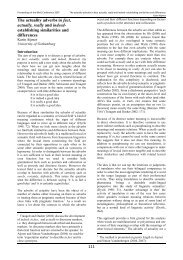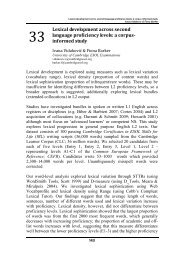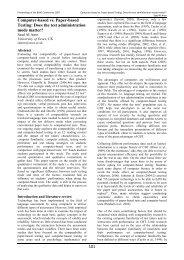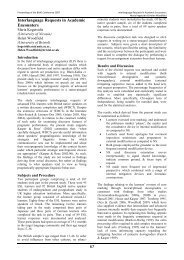Proceedings of the - British Association for Applied Linguistics
Proceedings of the - British Association for Applied Linguistics
Proceedings of the - British Association for Applied Linguistics
Create successful ePaper yourself
Turn your PDF publications into a flip-book with our unique Google optimized e-Paper software.
23<br />
Naxi, Chinese, English or ASEAN Languages: A Study <strong>of</strong> Language Policies <strong>of</strong> Naxi Community in Lijiang, China<br />
Hongyan Yang<br />
Naxi, Chinese, English or ASEAN<br />
Languages: A Study <strong>of</strong> Language Policies <strong>of</strong><br />
Naxi Community in Lijiang, China<br />
Hongyan Yang<br />
Macquarie University, Australia<br />
Yunnan Nationalities University, China<br />
hongyan.yang@mq.edu.au or yhyxhw@hotmail.com<br />
Among 56 <strong>of</strong>ficially-recognized nationalities in China, <strong>the</strong> dominant Han<br />
comprises about 92% <strong>of</strong> <strong>the</strong> total population while <strong>the</strong> o<strong>the</strong>r 55 minority<br />
groups represent about 110 million people with about 120 mo<strong>the</strong>r tongues<br />
and only 30 minority languages have written scripts. The Naxi ethnic<br />
minority in Lijiang, a tourist area <strong>of</strong> Yunnan in Southwest China, are <strong>of</strong><br />
particular interest as an ethnic minority due to <strong>the</strong>ir unique culture and<br />
diverse <strong>for</strong>ms <strong>of</strong> written language including <strong>the</strong> unique pictographic<br />
Dongba script. Naxi speak Naxi, local Chinese variety, mandarin Chinese<br />
and learn English or ASEAN languages as <strong>for</strong>eign languages. Having been<br />
recognized by UNESCO as <strong>the</strong> World Heritage site destinations, Lijiang<br />
has experienced a booming tourism with tourists from both home and<br />
abroad and has brought change to language policies and language practices<br />
among Naxi.<br />
There are several studies <strong>of</strong> Naxi on Naxi geography, culture and language,<br />
bilingual and trilingual education policy (Blach<strong>for</strong>d & Jones, 2011),<br />
language transfer (Hong, 2005), schooling and identity (Hansen, 2011; Yu,<br />
2010). However, <strong>the</strong>re is paucity <strong>of</strong> research that investigates <strong>the</strong> interplay<br />
<strong>of</strong> Naxi, Chinese and English/<strong>for</strong>eign languages policies and interrelation<br />
<strong>of</strong> language policies with linguistic power in a complicated multiethnic and<br />
multilingual context. Language policy is “ano<strong>the</strong>r mechanism through<br />
which ideology is meant to turn into practice or practice into ideology”<br />
(Shohamy, 2006, p. 76). This study aims to fill in this gap with <strong>the</strong><br />
<strong>the</strong>oretical frameworks <strong>of</strong> language policy to explore <strong>the</strong> hierarchical<br />
relationship between language, power and inequality. I argue that language<br />
policies <strong>of</strong> Naxi, Chinese, English and ASEAN languages and practices<br />
need to be meditated and justified from <strong>the</strong> sociolinguistic perspective and<br />
understood as local, national, social and political constructions in a<br />
multilingual, multiethnic and multicultural context. Two general questions<br />
guide this study. (1) What language policies have been implemented in<br />
Lijiang? (2) What is <strong>the</strong> gap between rhetoric and <strong>the</strong> reality on <strong>the</strong><br />
113







